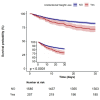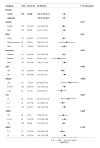Impact of unintentional weight loss on 30-day mortality in intensive care unit sepsis patients: a retrospective cohort study
- PMID: 39733192
- PMCID: PMC11682055
- DOI: 10.1038/s41598-024-83260-3
Impact of unintentional weight loss on 30-day mortality in intensive care unit sepsis patients: a retrospective cohort study
Abstract
This study aimed to investigate the relationship between unintentional weight loss and 30-day mortality in sepsis patients in the intensive care unit (ICU). A retrospective cohort study sepsis patients in the ICU was conducted using data from the Medical Information Mart for Intensive Care IV (MIMIC-IV) database, involving 1842 sepsis patients in the ICU. We utilized multivariate Cox regression analysis to evaluate the association between unintentional weight loss and the risk of 30-day mortality. In addition, we conducted stratified and interaction analyses to determine the consistency of this association across various demographic and clinical subgroups. Out of the 1842 patients, 19.2% (354) died within 30 days. The fully adjusted multivariate Cox regression model revealed that for every one-unit decrease in body weight, the risk of death increased by 58% (hazard ratio [HR] = 1.58; 95% confidence interval [CI] = 1.20-2.07). Unintentional weight loss was found to be positively correlated with 30-day mortality. Subgroup analysis yielded consistent results across all groups. Unintentional weight loss was positively associated with a greater risk of mortality in critically ill patients with sepsis in the ICU.
Keywords: 30-day mortality; Retrospective cohort study; Sepsis; Unintentional weight loss.
© 2024. The Author(s).
Conflict of interest statement
Declarations. Competing interests: The authors declare no competing interests.
Figures
References
-
- Weng, L. et al. Sepsis-related mortality in China: A descriptive analysis. Intensive Care Med.44(7), 1071–1080. 10.1007/s00134-018-5203-z (2018). - PubMed
-
- Reinhart, K. et al. Recognizing sepsis as a global health priority—A WHO resolution. N. Engl. J. Med.377(5), 414–417. 10.1056/NEJMp1707170 (2017). - PubMed
-
- Fleischmann, C. et al. Assessment of global incidence and mortality of hospital-treated sepsis. Current estimates and limitations. Am. J. Respir. Crit. Care Med.193(3), 259–272. 10.1164/rccm.201504-0781OC (2016). - PubMed
MeSH terms
LinkOut - more resources
Full Text Sources
Medical




